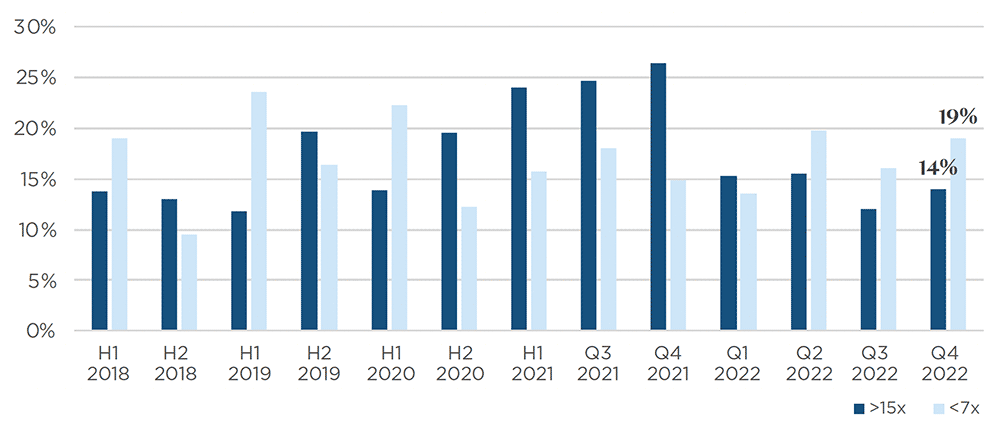Share
Main Conclusions
Limited decrease of the Argos Index®, now below 10.0x EBITDA
The Argos Index® has started to decline in Q4 at 9.9x EBITDA: it is now below 10x for the first time since Q2 2020. Multiples paid by both private equity funds and strategic buyers have shown a limited erosion.
This looks surprising in a quicky deteriorating macroeconomic environment: as inflation spiralled out of control due to lockdowns and the Russia-Ukraine war, central banks have increased interest rates, which resulted in a correction in public markets – that however bounced back in Q4 (1).
The expected fall of multiples has yet to materialize. As the M&A market cycle reverses, the gap between sellers’ and buyers’ price expectations takes time to narrow. But the process seems to have started, as the most recent deals of the Index sample have lower multiples.
This apparent stability also conceals the growing divergence, at a record level of 4.0x EBITDA, between the upper mid-market (now at 12.6x EBITDA) and the lower mid-market where multiples continue to decrease at 8.6x EBITDA. On the upper end of the market, dealmaking was concentrated on a much smaller number of quality assets with strong pricing power. As usual during periods of crisis, the market is getting more polarized, as shown is the high standard deviation of the Q4 Index.
The M&A mid-market activity fell in value by 43% (Q4 vs. Q3), led by the upper mid-market, and in line with the global M&A market trend. But the number of transactions remained remarkably stable in Q4 (vs. Q3) as well as for the full 2022 (vs. 2021).
Where the resilience of businesses was the strongest, forward-looking anticipations of sellers and buyers have been aligned enough to strike a price, which the index shows as being in line with the previous quarters’ practice.
Reversely, the drop in M&A values testifies that in many other cases, the buyers curbed down their anticipations for the businesses, while the vendors did not capitulate, and instead stuck to their positive views on the prospects of their companies.
The next quarters will be captivating in the discovery of which of the two views was right, in a context of strikingly high interest rates, inflation and geopolitical worries, … but in a landscape where unemployment remains low, and many businesses continue to thrive.
(1) The EURO STOXX® TMI Small was up 11.2% in Q4, back to its 30.06.2022 level.

Mid-market Argos Index® Median EV/EBITDA multiple on a six-month rolling basis
Source: Mid-market Argos Index© / Epsilon Research
Prices paid by private equity funds and strategic buyers have started to drop.
As reflected by the Argos Index®, both financial and strategic buyers multiples have slightly declined in Q4.
Multiples paid by investment funds are down 2% at 10.5x EBITDA in Q4 while the number of private equity deals is down 12% this quarter, which reflects the more difficult LBO financing conditions (interest rates hikes and banks’ increased selectivity). Fundraising has dropped to its lowest level since 2014, but private equity funds continue to benefit from record levels of money available for investment and are still active on quality assets, at high prices.
Multiples paid by strategic buyers are also slighlty down at 9.8x EBITDA. With a remarkably stable level since Q4 2021 they are apparently insulated from equity market volatility. Large corporates take advantage of the market downturn to find attractive growth opportunities and continue to transform their business models on the face of structural changes (digitalisation, ESG, changes in consumer behaviour).

Enterprise value / historical EBITDA
Source: Mid-market Argos Index© / Epsilon Research
Transactions at multiples > 15x back to pre-Covid levels

Share of transactions at multiples >15x EBITDA Argos Index™ sample
Source: Mid-market Argos Index© / Epsilon Research

Share of transactions with multiples < 7x EBITDA and > 15x EBITDA Argos Index™ sample
Source: Mid-market Argos Index© / Epsilon Research
Mid-market M&A activity fall in value, driven by the upper market, but is stable in volume
Euro zone M&A activity fell in value by 43% in Q4 (vs. Q3), largely due to the 57% drop of the upper mid-market (deals between €150m and €500m). However, the number of transactions remained stable (+3% vs. Q3) pulled by smaller deals, which proved once again a more resilient market.
For the full 2022, the number of deals also stayed remarkably stable compared to 2021. The 2022 mid-market activity continued to show more resilience than the global M&A market: it decreased by 18% in value vs. 39% for the full European M&A market (1) – although it is still at high levels by historical standards.
The slowdown is the result of interest rate hike (2), in the wake of spiralling inflation and the war in Ukraine, hitting confidence in global markets and increasing the cost of financing. But the mid-market activity also reflected the resilience of euro-zone economies, which have outperformed expectations, as reflected in lower energy prices, GDP growth (3) or PMI (4).
(1) In 2022 the European M&A market decreased by 39% in value to $850.7bn, a 3-year low (source: Refinitiv)
(2) The ECB has raised key interest rates by 250 basis points since summer.
(3) The region GDP has grown by 4% and 2.1% year-on-year in Q2 and Q3 2022, respectively, beating most forecasts. Forecast growth is now 3.4% for 2022, 0,5% for 2023.
(4) The S&P Global Eurozone Composite PMI was revised to 49.3 in Dec. 2022, up from 48.8.

Eurozone mid-market activity (€15–500m) in volume and value
Source: Epsilon Research / MarketIQ

Share of LBO in Eurozone Mid-market M&A
Source: Epsilon Research / MarketIQ











